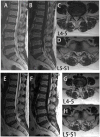Unilateral biportal endoscopy vs. open decompression for lumbar epidural lipomatosis-cohort study using a prospective registry
- PMID: 38721124
- PMCID: PMC11076726
- DOI: 10.3389/fneur.2024.1366357
Unilateral biportal endoscopy vs. open decompression for lumbar epidural lipomatosis-cohort study using a prospective registry
Abstract
Objective: This study aimed to compare the outcomes of unilateral biportal endoscopy, unilateral laminectomy bilateral decompression (UBE-ULBD), and open lumbar decompression (OLD) in patients with lumbar epidural lipomatosis (LEL).
Methods: This prospective observational study was conducted from March 2019 to May 2022 and encompassed 33 patients with LEL who underwent lumbar decompression. The study included 15 cases of UBE-ULBD decompression and 18 cases of open decompression, which were followed up for 1 year. The baseline characteristics, initial clinical manifestations, and surgical details [including estimated blood loss (EBL) and preoperative complications] of all patients were recorded. Radiographic evaluation included the cross-sectional area (CSA) of the thecal sac and paraspinal muscles on MRI. Clinical results were analyzed using the Short Form-36 Score (SF-36), the Numeric Pain Rating Scale (NRS) for lumbar and leg pain, creatine kinase, the Roland and Morris Disability Questionnaire (RMDQ), and the Oswestry Disability Index (ODI).
Results: The dural sac CSA increased considerably at the 1-year postoperative follow-up in both groups (p < 0.001). The operative duration in the OLD group (48.2 ± 7.2 min) was shorter than that in the UBE-ULBD group (67.7 ± 6.3 min, p < 0.001). The OLD group (97.2 ± 19.8 mL) was associated with more EBL than the UBE-ULBD group (40.6 ± 13.6 mL, p < 0.001). The duration of hospitalization in the OLD group (5.4 ± 1.3 days) was significantly longer compared with the UBE-ULBD group (3.5 ± 1.2 days, p < 0.01). The SF-36, NRS, RMDQ, and ODI scores improved in both groups postoperatively (p < 0.001). Serum creatine kinase values in the UBE-ULBD group (101.7 ± 15.5) were significantly lower than those in the OLD group (330.8 ± 28.1 U/L) 1 day after surgery (p < 0.001). The degree of paraspinal muscle atrophy in the UBE-ULBD group (4.81 ± 1.94) was significantly lower than that in the OLD group (12.15 ± 6.99) at 1 year (p < 0.001).
Conclusion: UBE-ULBD and OLD demonstrated comparable clinical outcomes in treating LEL. However, UBE-ULBD surgery was associated with shorter hospital stays, lower rates of incision infection, lighter paravertebral muscle injury, and lower EBL than OLD surgery. Consequently, UBE-ULBD can be recommended in patients with LEL if conservative treatment fails.
Keywords: OLD; UBE; UBE-ULBD; lumbar epidural lipomatosis; lumbar spinal stenosis.
Copyright © 2024 Tan, Zheng, Lei, Ouyang, Wen, Shi and Yang.
Conflict of interest statement
The authors declare that the research was conducted in the absence of any commercial or financial relationships that could be construed as a potential conflict of interest.
Figures


References
LinkOut - more resources
Full Text Sources

